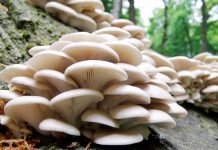Mushroom Substrates Preparation process
A suitable area needs to be set aside for preparing the substrate. For best results it should consist of a large concrete floor which has a slope, so that run-off can be collected and reused. A storage area is needed for the straw, chicken manure etc used to make the substrate, but the longer any manure is stored the more nitrogen will be lost. Another smaller area is required for filling the substrate into its growing bags or trays. This is usually roofed and walled. Lime, gypsum, small tools and chemicals for pest and disease control should be stored separately is a secure area.
The preparation to make a substrate for Pleurotus involves mixing with water. This can be done by
- Spraying the heap of material with a hose
- Making a flat pile and using a sprinkler
- Soaking in a tank of water.
Soaking requires a suitable container for mixing the water and the substrate materials together to allow the straw etc to soak up water. Alternatively a pit can be dug. The size of the
container will depend on the scale of production. For small scale operation 100 to 200 litres capacity is suitable. It needs to be 60cm deep. If it is not watertight then a liner of thick plastic can be used. A cover is used to help submerge the substrate material that would otherwise float in the water. The cover may need to be weighted down.
Blocks of substrate can be made more easily from material (straw etc) that has been cut into uniform pieces before being submerged. Other materials may not need pre treatment.
The substrate is submerged in water for 10 days, during which time it partially ferments and any insects in the material are killed. During this time the substrate absorbs the water so the level of water needs to be checked. If the substrate is no longer submerged then more water needs to be added along with an appropriate amount of fungicide. The fermentation will take place between 8 to 28°C. After this period the excess water can be drained off. The resulting material may initially smell sour.
The substrate can then be stored in strong plastic bags of around 30 to 40cm diameter which will hold around 20 to 30kg of material.
Another approach to eliminating unwanted pests is to stack the substrate material to the desired height to form a large enough body of material to generate heat but small enough to ensure that air can get to the middle of the stack producing aerobic decomposition (1.5 to 2m wide by 1 to 1.5m high). This kills off the pests. A wooden frame can be used when making the stack to get the right size and keep it uniform.
The prepared substrate is then ready for growing mushrooms, but it is also an ideal medium for other unwanted plants, fungi and bugs. Therefore hygiene is an important element to producing a successful crop. To eliminate any competitor organisms a fungicide can be added to the water to prevent mould but which does not inhibit the growth of the mushrooms.
Alternatively, the substrate can be steam heated to eliminate any microbes. This is especially important when using manure in the substrate. This can be done using a pasteuriser made from an old 200 litre drum with suitable modifications so the substrate can be held above the boiling water which is at the bottom of the drum.
Small-scale producers can benefit by sharing this task. The sterile substrate can be prepared at a central location, to ensure correct production. After filling the plastic bags with spawned substrate, they can be distributed to the mushroom farmers.



